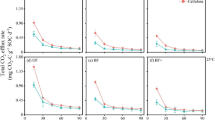Abstract
Trees allocate a large portion of gross primary production belowground for the production and maintenance of roots and mycorrhizae. The difficulty of directly measuring total belowground carbon allocation (TBCA) has limited our understanding of belowground carbon (C) cycling and the factors that control this important flux. We measured TBCA over 4 years using a conservation of mass, C balance approach in replicate stands of fast growing Eucalyptus saligna Smith with different nutrition management and tree density treatments. We measured TBCA as surface carbon dioxide (CO2) efflux (“soil” respiration) minus C inputs from aboveground litter plus the change in C stored in roots, litter, and soil. We evaluated this C balance approach to measuring TBCA by examining (a) the variance in TBCA across replicate plots; (b) cumulative error associated with summing components to arrive at our estimates of TBCA; (c) potential sources of error in the techniques and assumptions; (d) the magnitude of changes in C stored in soil, litter, and roots compared to TBCA; and (e) the sensitivity of our measures of TBCA to differences in nutrient availability, tree density, and forest age. The C balance method gave precise estimates of TBCA and reflected differences in belowground allocation expected with manipulations of fertility and tree density. Across treatments, TBCA averaged 1.88 kg C m−2 y−1 and was 18% higher in plots planted with 104 trees/ha compared to plots planted with 1111 trees/ha. TBCA was 12% lower (but not significantly so) in fertilized plots. For all treatments, TBCA declined linearly with stand age. The coefficient of variation (CV) for TBCA for replicate plots averaged 17%. Averaged across treatments and years, annual changes in C stored in soil, the litter layer, and coarse roots (−0.01, 0.06, and 0.21 kg C m−2 y−1, respectively) were small compared with surface CO2 efflux (2.03 kg C m−2 y−1), aboveground litterfall (0.42 kg C m−2 y−1), and our estimated TBCA (1.88 kg C m−2 y−1). Based on studies from similar sites, estimates of losses of C through leaching, erosion, or storage of C in deep soil were less than 1% of annual TBCA.
Similar content being viewed by others
Author information
Authors and Affiliations
Additional information
Received 6 March 2001; accepted 7 January 2002.
Rights and permissions
About this article
Cite this article
Giardina, C., Ryan, M. Total Belowground Carbon Allocation in a Fast-growing Eucalyptus Plantation Estimated Using a Carbon Balance Approach. Ecosystems 5, 487–499 (2002). https://doi.org/10.1007/s10021-002-0130-8
Issue Date:
DOI: https://doi.org/10.1007/s10021-002-0130-8




